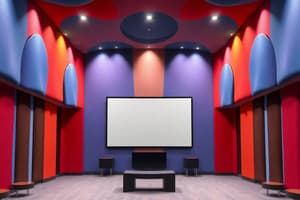Podcast
Questions and Answers
What is the purpose of conducting listening tests in optimizing room acoustics?
What is the purpose of conducting listening tests in optimizing room acoustics?
- To evaluate the impact of adjustments on sound quality (correct)
- To select the right acoustic materials
- To identify the ideal speaker placement
- To measure the reverberation time
What can acoustic treatment solutions such as absorptive panels and diffusers help minimize?
What can acoustic treatment solutions such as absorptive panels and diffusers help minimize?
- Audio calibration errors
- Speaker placement issues
- Sound quality
- Unwanted reflections and resonances (correct)
What is the purpose of calibration tools in advanced audio setups?
What is the purpose of calibration tools in advanced audio setups?
- To optimize speaker placement
- To reduce reverberation time
- To select acoustic materials
- To measure and equalize speaker response (correct)
What is reverberation time measured in?
What is reverberation time measured in?
What is the primary purpose of absorption materials in room acoustics?
What is the primary purpose of absorption materials in room acoustics?
What is the goal of diffusion in room acoustics?
What is the goal of diffusion in room acoustics?
Why is speaker placement crucial in optimizing room acoustics?
Why is speaker placement crucial in optimizing room acoustics?
What can diffusion panels help achieve in a room?
What can diffusion panels help achieve in a room?
Why is it important to consider the room's intended use when optimizing reverberation time?
Why is it important to consider the room's intended use when optimizing reverberation time?
What is the primary role of absorptive panels in room acoustics?
What is the primary role of absorptive panels in room acoustics?
What is the primary factor to consider when placing speakers in a room?
What is the primary factor to consider when placing speakers in a room?
What is the purpose of using isolation pads or stands for speakers?
What is the purpose of using isolation pads or stands for speakers?
What is the primary goal of designing for room acoustics?
What is the primary goal of designing for room acoustics?
What is the effect of optimizing the interaction between speakers and the room?
What is the effect of optimizing the interaction between speakers and the room?
What is the result of implementing room acoustics techniques effectively?
What is the result of implementing room acoustics techniques effectively?
What is the primary role of room acoustics in a space?
What is the primary role of room acoustics in a space?
Which type of surface is most likely to create unwanted echoes in a room?
Which type of surface is most likely to create unwanted echoes in a room?
What is the purpose of using acoustic panels or diffusers in a room?
What is the purpose of using acoustic panels or diffusers in a room?
How can furniture and interior elements affect the acoustics in a room?
How can furniture and interior elements affect the acoustics in a room?
Why is it important to consider the design and installation of HVAC systems in a room?
Why is it important to consider the design and installation of HVAC systems in a room?
What is the primary consequence of smooth, hard surfaces in a room?
What is the primary consequence of smooth, hard surfaces in a room?
What is the purpose of strategically placing furniture within a room?
What is the purpose of strategically placing furniture within a room?
What is the overall goal of designing for room acoustics?
What is the overall goal of designing for room acoustics?
What type of room shape can create focused listening areas along the length of the room?
What type of room shape can create focused listening areas along the length of the room?
What is the primary purpose of bass traps in room acoustics?
What is the primary purpose of bass traps in room acoustics?
Which type of acoustic material is effective in absorbing mid to high-frequency sounds?
Which type of acoustic material is effective in absorbing mid to high-frequency sounds?
What is the primary function of diffusers in room acoustics?
What is the primary function of diffusers in room acoustics?
Which material is commonly used as a reflector in room acoustics?
Which material is commonly used as a reflector in room acoustics?
What type of resonator is used to absorb sound at a specific frequency?
What type of resonator is used to absorb sound at a specific frequency?
What is the primary purpose of Mass Loaded Vinyl in room acoustics?
What is the primary purpose of Mass Loaded Vinyl in room acoustics?
Why is it important to consider the room shape and dimensions when designing for room acoustics?
Why is it important to consider the room shape and dimensions when designing for room acoustics?
What is the primary purpose of acoustic materials in room acoustics?
What is the primary purpose of acoustic materials in room acoustics?
What is the primary challenge of setting up a home studio in a small room?
What is the primary challenge of setting up a home studio in a small room?
What is the primary purpose of isolation mounts?
What is the primary purpose of isolation mounts?
What is the first step in designing for room acoustics?
What is the first step in designing for room acoustics?
Why should speakers be positioned away from walls?
Why should speakers be positioned away from walls?
What is the purpose of angling and tilting speakers?
What is the purpose of angling and tilting speakers?
At what height should speakers be mounted for ideal sound quality?
At what height should speakers be mounted for ideal sound quality?
What is the primary listening position in a room?
What is the primary listening position in a room?
What should be considered when placing listeners in a room?
What should be considered when placing listeners in a room?
Why is experimentation and fine-tuning necessary after initially placing speakers and listeners?
Why is experimentation and fine-tuning necessary after initially placing speakers and listeners?
What is the ultimate goal of designing for room acoustics?
What is the ultimate goal of designing for room acoustics?
Why are acoustic materials essential in designing for room acoustics?
Why are acoustic materials essential in designing for room acoustics?
What is the primary reason why larger rooms tend to have longer reverberation times?
What is the primary reason why larger rooms tend to have longer reverberation times?
What is the effect of background noise on room acoustics?
What is the effect of background noise on room acoustics?
What is the primary concern when designing a room for optimal acoustics?
What is the primary concern when designing a room for optimal acoustics?
What is the effect of standing waves on the listening experience?
What is the effect of standing waves on the listening experience?
What is the primary reason why room modes are a concern in acoustic design?
What is the primary reason why room modes are a concern in acoustic design?
What is the effect of an irregularly shaped room on sound absorption treatments?
What is the effect of an irregularly shaped room on sound absorption treatments?
What is the primary goal of acoustic design in a room?
What is the primary goal of acoustic design in a room?
What is the effect of a room's shape and dimensions on sound reflections?
What is the effect of a room's shape and dimensions on sound reflections?
What is the primary concern when designing a room for musical performances?
What is the primary concern when designing a room for musical performances?
Why is it recommended to avoid square or rectangular room shapes with equal dimensions?
Why is it recommended to avoid square or rectangular room shapes with equal dimensions?
Flashcards are hidden until you start studying
Study Notes
Factors Influencing Room Acoustics
- Room shape, dimensions, and use of acoustic materials significantly impact room acoustics
- Reflective surfaces (walls, ceilings, floors) can create longer reverberation times and unwanted echoes
- Absorptive materials (acoustic panels, diffusers) help reduce sound reflections and control sound balance
- Furniture and interior elements (upholstery, rugs, curtains) affect acoustics, with soft materials absorbing sound and hard materials reflecting it
- HVAC systems can interfere with sound quality and should be designed with noise reduction in mind
- Room volume directly affects acoustic properties, with larger rooms having longer reverberation times and more diffuse sound
Room Shape and Dimensions
- Room shape and dimensions influence how sound behaves within the room
- Reflections and standing waves can be minimized by avoiding parallel walls and equal dimensions
- Room modes (resonant frequencies) can cause uneven bass response and should be addressed
- Broadband absorption is affected by room shape, with irregularly shaped rooms requiring less absorption
- Room geometry influences sound distribution, with different shapes creating different sound dispersion patterns
Use of Acoustic Materials
- Acoustic materials (absorbers, diffusers, reflectors, resonators, barrier materials, vibration control) are essential for optimizing room acoustics
- Absorbers (acoustic panels, bass traps, acoustic foam) reduce echo and reverberation
- Diffusers (quadratic, skyline) scatter sound waves to prevent concentrated reflections
- Reflectors (gypsum board, glass, metal) redirect sound waves towards specific areas
- Resonators (Helmholtz, membrane absorbers) absorb sound at specific frequencies
- Barrier materials (mass loaded vinyl, acoustic curtains) block sound transmission
- Vibration control (isolation mounts) reduces vibrations transferred through floors and walls
Arranging Speaker and Listener Placement
- Defining the listening area and positioning speakers and listeners is critical for optimal sound quality
- Speaker placement should consider distance from walls, symmetry, angle, and tilt
- Listener placement should account for the sweet spot, room modes, and reflections
- Experimentation and fine-tuning are necessary to achieve optimal results
Optimizing Room Acoustics
- Understanding reverberation time and its impact on sound quality is essential
- Optimizing reflection patterns using absorption materials can enhance sound quality
- Diffusion techniques can scatter sound waves to create a more balanced sound experience
- Optimizing speaker placement can minimize unwanted reflections and resonances
- Careful consideration of various factors and techniques is necessary for designing an acoustically superior environment
Studying That Suits You
Use AI to generate personalized quizzes and flashcards to suit your learning preferences.




